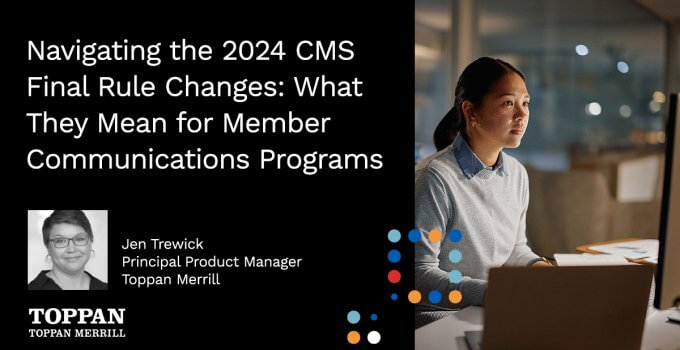As the Medicare Advantage (MA) open enrollment period approaches, Medicare Advantage Organizations (MAOs) gear up for one of their busiest times of the year. In a season where every detail counts, member communication documents such as the Annual Notice of Change (ANOC), Evidence of Coverage (EOC), and other mandated letters must be delivered the right way and at the right time. And it’s not just about compliance—it’s about ensuring a seamless, efficient process that enhances the member experience, even as shifting regulations muddy the waters.
This year, MAOs face a regulatory landscape that’s evolving yet again, with changes that will redefine how they approach member communications. At the heart of this shift is the 2024 CMS Final Rule, which builds on the groundwork laid by last year’s adjustments. These updates don’t just tweak the process—they compel MAOs to rethink and recalibrate their strategies to stay ahead, all while ensuring their members receive clear, accessible information in an increasingly complex environment.
Here is a breakdown of some of the most impactful changes and how your team can prepare.
2024 CMS Final Rule targets accessibility in member communications
One of the core aims of the 2024 CMS Final Rule is to enhance accessibility in healthcare communications, ensuring that underserved populations can better understand and navigate their health plans. The rule specifically focuses on two populations that have historically faced barriers in accessing healthcare information:
- Members with limited English proficiency (LEP)
- Members with disabilities
The emphasis is to create a more inclusive healthcare system where every member—regardless of language or ability—can easily access the information they need to make informed decisions about their care. For MAOs, this means communications must be clear, accessible, and available in multiple formats to meet diverse member needs.
Changes to accessibility requirements for 2024
So, what do these changes look like in practice for Medicare Advantage plans? The 2024 CMS Final Rule introduces several critical updates that reshape how MAOs have to handle their member communications:
- Section 508 compliance: All communications, including posted PDFs, must meet accessibility standards and be available in tagged, accessible formats.
- Language thresholds: For any service area where 5% or more of the population speaks a non-English language, health plans must offer translations in that language.
- Accessible formats for disabilities: Communications must be made available in alternative formats such as Braille, audio, and large print for members with disabilities.
These changes mean that MAOs will need to significantly expand the variety of formats they use to deliver key member communications like the ANOC and EOC and other mandated letters, ensuring every member can easily access and understand the information in a way that suits their needs.
A major shift: changes to the default delivery method
One of the most notable changes in the 2024 CMS Final Rule is the shift in how member communication preferences are handled. In the past, members had to request alternative formats—such as large print, Braille, or audio—on a case-by-case basis for each document they received. This placed the burden on the member to continually specify their preferred delivery format, creating unnecessary hurdles.
Starting in 2024, that changes. Once a member requests an alternative format, MAOs must deliver all future communications in that format—automatically, for the duration of the member’s enrollment, unless the member specifies otherwise. For example, if a member requests large print in Spanish, every document from the health plan must be delivered in large print and in Spanish, without requiring additional requests.
This new directive alleviates the administrative burden on members and shifts it squarely onto the MAOs, adding an extra layer of complexity to communication strategies.
CMS changes bring challenges for MAOs in 2024
This increased emphasis on accessibility comes with heightened challenges for MA plans. The need to deliver communications in a variety of formats—across different languages and accessibility formats—means MAOs will be dealing with both higher volumes and greater complexity. Some of the key challenges MAOs may face include:
- Time-intensive translations: Translating documents into multiple languages, particularly for complex documents like the ANOC and EOC, can take days or even weeks.
- Creation of accessible formats: Producing materials in alternative formats such as large print or Braille also requires additional time and specialized resources.
- Tighter turnaround times: Some regulatory requirements have shortened the window for delivering these documents, forcing plans to accelerate their processes, sometimes with as little as a few days to comply with requests.
The reality is, the 2024 changes are not just about meeting new standards—they require a fundamental shift in how MAOs manage their communications. The key will be thinking proactively, not reactively, to ensure they’re ready to meet member needs without getting bogged down in last-minute scrambles.
Is your delivery partner equipped to handle these changes?
As the demands on member communications grow, many MAOs will need to take a closer look at their delivery partners. While some partners excel in standard print communications, they may not be equipped to handle the increased volume or variety of formats that the new CMS regulations will require. In fact, many delivery partners rely on third-party vendors for one-off requests like Braille or translations, and these relationships typically lack the scalability needed for what’s coming.
Now is the time for MAOs to assess whether their partners can handle the upcoming changes. Do they have the ability to deliver documents in multiple formats at scale? Can they manage the logistics of tracking member preferences and ensuring compliance across all communications?
And can they do it all while keeping costs under control?
The bottom line is that MAOs need delivery partners that can offer more than just standard print. They need partners with the flexibility, technology, and expertise to navigate these new challenges smoothly and efficiently.
*Keep an eye out for an upcoming blog on how to evaluate your vendor partners so you can meet regulatory requirements while delivering exceptional member experiences and protecting your bottom line.
The 2024 CMS Final Rule presents both opportunities and challenges for Medicare Advantage plans. By expanding accessibility requirements, CMS is making strides toward a more inclusive healthcare system. However, these changes will require significant adjustments to how MAOs deliver their communications—especially when it comes to handling alternative formats and tighter timelines.
Toppan Merrill can help you navigate Final Rule changes
At Toppan Merrill, we make it our business to stay on top of Final Rule changes, so you don’t have to, ensuring we’re ready to help MAOs meet new demands head-on. With our expertise and proactive support, we can help you streamline your communication strategies all while staying compliant. See how Toppan Merrill can help you navigate the complexities of these evolving requirements, so you can focus on delivering exceptional care and support to your members during this critical open enrollment period.
Learn more about Toppan Merrill Health Plans Member Communications



